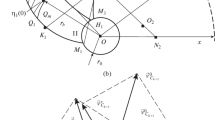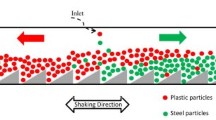Abstract
Mathematical assessment of homogenisation progress of the granular material mixing process is presented. The mixing process was realised using a vessel in the form of two partly penetrating horizontal cylinders equipped with two multi-ribbon agitators. The experimental system consisted of three sets of particles of different colour. Random states of the mixed granular material were characterised by the sampling procedure at different moments of the mixing process. Informational entropy as well as the flow of quantum of information were applied to describe the progress of the homogenisation process. Analysis of this process was based on experimental investigations in the form of informational entropy patterns and described by means of the average informational entropy or the quantum of information.
Similar content being viewed by others
References
Akiyama, T., Iguchi, T., Aoki, K., & Nishimoto, K. (1998). A fractal analysis of solids mixing in two-dimensional vibrating particle beds. Powder Technology, 97, 63–71. DOI: S0032-5910(97)03400-1.
Asmar, B. N., Langston, P. A., & Matachett, A. J. (2002). A generalized mixing index in distinct element method simulation of vibrated particulate beds. Granular Matter, 4, 129–138. DOI: 10.1007/s10035-002-0112-8.
Austin, L. G. (1971). Introduction to the mathematical description of grinding as a rate process. Powder Technology, 5, 1–17. DOI: 10.1016/0032-5910(71)80064-5.
Austin, L. G. (1995). The graphical representation of ash liberation in milled coal. Chemical Engineering Journal, 59, 23–31. DOI: 10.1016/0923-0467(95)03009-3.
Austin, L. G. (1999). A discussion of equations for the analysis of batch grinding data. Powder Technology, 106, 71–77. DOI: 10.1016/S0032-5910(99)00047-9.
Berthiaux, H., Heitzmann, D., & Dodds, J. D. (1996). Validation of a model of a stirred bead mill by comparing results obtained in batch and continuous mode grinding. International Journal of Mineral Processing, 44/45, 653–661. DOI: 10.1016/0301-7516(95)00073-9.
Berthiaux, H., & Mizonov, V. (2004). Applications of Markov chains in particulate process engineering: A review. The Canadian Journal of Chemical Engineering, 82, 1143–1168.
Bridgwater, J. (2003). The dynamics of granular materials — towards grasping the fundamentals. Granular Matter, 4, 175–181. DOI: 10.1007/s10035-002-0120-8.
Brone, D., Alexander, A., & Muzzio, F. J. (1998). Quantitative characterization of mixing of dry powders in V-blenders. AIChE Journal, 44, 271–278. DOI: 10.1002/aic.690440206.
Chen, S. J., Fan, L. T., & Watson, C. A. (1972). The mixing of solid particles in a motionless mixer — a stochastic approach. AIChE Journal, 18, 984–989. DOI: 10.1002/aic.690180515.
Cho, H., Yildirim, K., & Austin, L. G. (1998). The conversion of sedigraph size distributions to equivalent sub-sieve screen size distributions. Powder Technology, 95, 109–117. DOI: 10.1016/S0032-5910(97)03326-3.
Chou, S. T., Fan, L. T., & Hsu, J. P. (1987). Stochastic analysis of the transient behavior of an msmpr crystallizer; effects of the seed size distribution and size dependent growth, rate, Probability in the Engineering and Informational Sciences, 1, 383–404.
Gardner, R. P., & Austin, L. G. (1962). A chemical engineering treatment of batch grinding. In H. Rumpf and D. Behrens (Eds.), Proceedings of the 1st European Symposium on Size Reduction (pp. 217–248). Düsseldorf: Verlag Chemie.
Heim, A., Olejnik, T. P., & Pawlak, A. (2005). Using statistical moments to describe grinding in a ball mill for industrial-scale process. Chemical Engineering and Processing, 44, 263–266. DOI: 10.1016/j.cep.2004.02.020.
Henrique, C., Batrouni, G., & Bideau, D. (2001). Diffusion as a mixing mechanism in granular materials. Physical Review E, 63, 011304. DOI: 10.1103/PhysRevE.63.011304.
Hoyer, D. I. (1995). Batch grinding simulation — population balance models and self-similar size distributions. Materials Engineering, 8, 1275–1284. DOI: 10.1016/0892-6875(95)00095-8.
Hulburt, H. M., & Katz, S. (1964). Some problems in particle technology: A statistical mechanical formulation. Chemical Engineering Science, 19, 555–574. DOI: 10.1016/0009-2509(64)85047-8.
Khakhar, D. V., McCarthy, J. J., & Ottino, J. M. (1997). Radial segregation of granular mixtures in a rotating cylinder. Physics of Fluids, 9, 3600–3614. DOI: 10.1063/1.869498.
Kruszyński, B. W., & Wójcik, R. (2001). Residual stress in grinding. Journal of Materials Processing Technology, 109, 254–257. DOI: 10.1016/S0924-0136(00)00807-4.
Lai, F. S., & Fan, L. T. (1975). Application of a discrete mixing model to the study of mixing of multicomponents solid particles. Industrial & Engineering Chemistry Process Design and Development, 14, 403–411. DOI: 10.1021/i260056a009.
Laurent, B. F. C., & Bridgwater, J. (2002). Performance of single and six-bladed powder mixers. Chemical Engineering Science, 57, 1695–1709. DOI: 10.1016/S0009-2509(02)00052-0.
Laurent, B. F. C., Bridgwater, J., & Parker, D. J. (2000). Motion in a particle bed agitated by a single bed. AIChE Journal, 46, 1723–1734. DOI: 10.1002/aic.690460904.
Makarow, J. I. (1975). Foundations of calculations of powder material blending, Doctor’s Thesis, Moscow: MIKhM.
Marchiso, D. L., Vigil, R. D., & Fox R. O. (2003). Implementation of the quadrature method of moments in CFD codes for aggregation-breakage problems. Chemical Engineering Science, 58, 3337–3351. DOI: 10.1016/S0009-2509(03)00211-2S0009-2509(03)00211-2.
Masiuk, S., & Rakoczy, R. (2006). The entropy criterion for the homogenisation process in a multi-ribbon blender. Chemical Engineering and Processing: Process Intensification, 45, 500–506. DOI: 10.1016/j.cep.2005.11.008.
Masiuk, S., & Rakoczy, R. (2008). Kinetic equation of grinding process in mixing of granular material using probability density functions, transient operators and informational entropy. Chemical Engineering and Processing, 47, 200–208. DOI: 10.1016/j.cep.2007.03.001.
McCarthy, J. J., & Ottino, J. M. (1998). Particle dynamics simulation: A hybrid technique applied to granular mixing. Powder Technology, 97, 91–99. DOI: S0032-5910(97)03391-3.
McCarthy, J. J., Khakhar, J. M., & Ottino, J. M. (2000). Computational studies of granular mixing. Powder Technology, 109, 72–82. DOI: S0032-5910(99)00228-4.
Moakher, M., Shinbrot, T., & Muzzio, F. J. (2000). Experimentally validated computations of flow, mixing and segregation of non-cohesive grains in 3D tumbling blenders. Powder Technology, 109, 58–71. DOI: S0032-5910(99)00227-2.
Molina-Boisseau, S., & Le Bolay, N. (2002). The mixing of a polymeric powder and the grinding medium in a shaker bead mill. Powder Technology, 123, 212–220. DOI: S0032-5910(01)00460-0.
Müller, F., Polke, R., & Schäfer, M. (1999). Model-based evaluation of grinding experiments. Powder Technology, 105, 243–249. DOI: 10.1016/S0032-5910(99)00144-8.
Niemi, A., Tian, L., & Ylinen, R. (1997). Model predictive control for grinding systems. Control Engineering Practice, 5, 271–278. DOI: 10.1016/S0967-0661(97)00236-0.
Ogawa, K., & Inoue, I. (1984). A new definition of quality of mixedness for multicomponents batch mixing. In Proceedings of 8th International Congress CHISA’84, 3–7 September 1984 (Pap. V3.56), Prague: CHISA.
Ogawa, K., & Ito, S. (1975). A definition of quality of mixedness. Journal of Chemical Engineering of Japan, 8, 148–151.
Ogawa, K., Ito, S., & Matsumura, Y. (1980). Mixing rate in a stirred vessel. Journal of Chemical Engineering of Japan, 13, 324–326.
Pernenkil, L., & Cooney, C. L. (2006). A review on the continuous blending of powders. Chemical Engineering Science, 61, 720–742. DOI: 10.1016/j.ces.2005.06.016.
Ramkrishna, D. (2000). Population balances. Theory and applications to particulate system in engineering, San Diego: Academic Press.
Randolph, A. D., & Larson, M. A. (1988). Theory of particulate processes. New York: Academic Press, New York.
Runkana, V., Somasundaran, P., & Kaptur, P. C. (2004). Mathematical modeling of polymer-induced flocculation by charge neutralization. Journal of Colloid and Interface Science, 270, 347–358. DOI: 10.1016/j.jcis.2003.08.076.
Sudah, O. S., Coffin-Beach, D., & Muzzio, F. J. (2002). Quantitative characterization of mixing of free-flowing granular material in tote (bin)-blenders. Powder Technology, 126, 191–200. DOI: 10.1016/S0032-5910(02)00006-2.
Unger, D. R., Muzzio, F. J., & Brodkey, R. S. (1998). Experimental and numerical characterization of viscous flow and mixing in an impinging jet contactor. Canadian Journal of Chemical Engineering, 76, 546–555.
Valery, W., & Morrell, S. (1995). The development of a dynamic model for autogenous and semi-autogenous grinding. Materials Engineering, 8, 1285–1297. DOI: 10.1016/0892-6875(95)00096-9.
Yekeler, M., Ozkan, A., & Austin, L. G. (2001). Kinetics of fine wet grinding in a laboratory ball mill. Powder Technology, 114, 224–228. DOI: 10.1016/S0032-5910(00)00326-0.
Yildirim, K., & Austin, L. G. (1998). The abrasive wear of cylindrical grinding media. Wear, 218, 15–20. DOI: 10.1016/S0043-1648(98)00198-7.
Zhukov, V., Mizonov, V., Filitchev, P., & Bernotat, S. (1998). The modelling of grinding process by means of the principle of maximum entropy. Powder Technology, 95, 248–253. DOI: S0032-5910(97)03344-5.
Author information
Authors and Affiliations
Corresponding author
Rights and permissions
About this article
Cite this article
Masiuk, S., Rakoczy, R.M. & Kordas, M. Entropy criterion of random states for granular material in a mixing process. Chem. Pap. 62, 247–254 (2008). https://doi.org/10.2478/s11696-008-0019-x
Received:
Revised:
Accepted:
Published:
Issue Date:
DOI: https://doi.org/10.2478/s11696-008-0019-x




